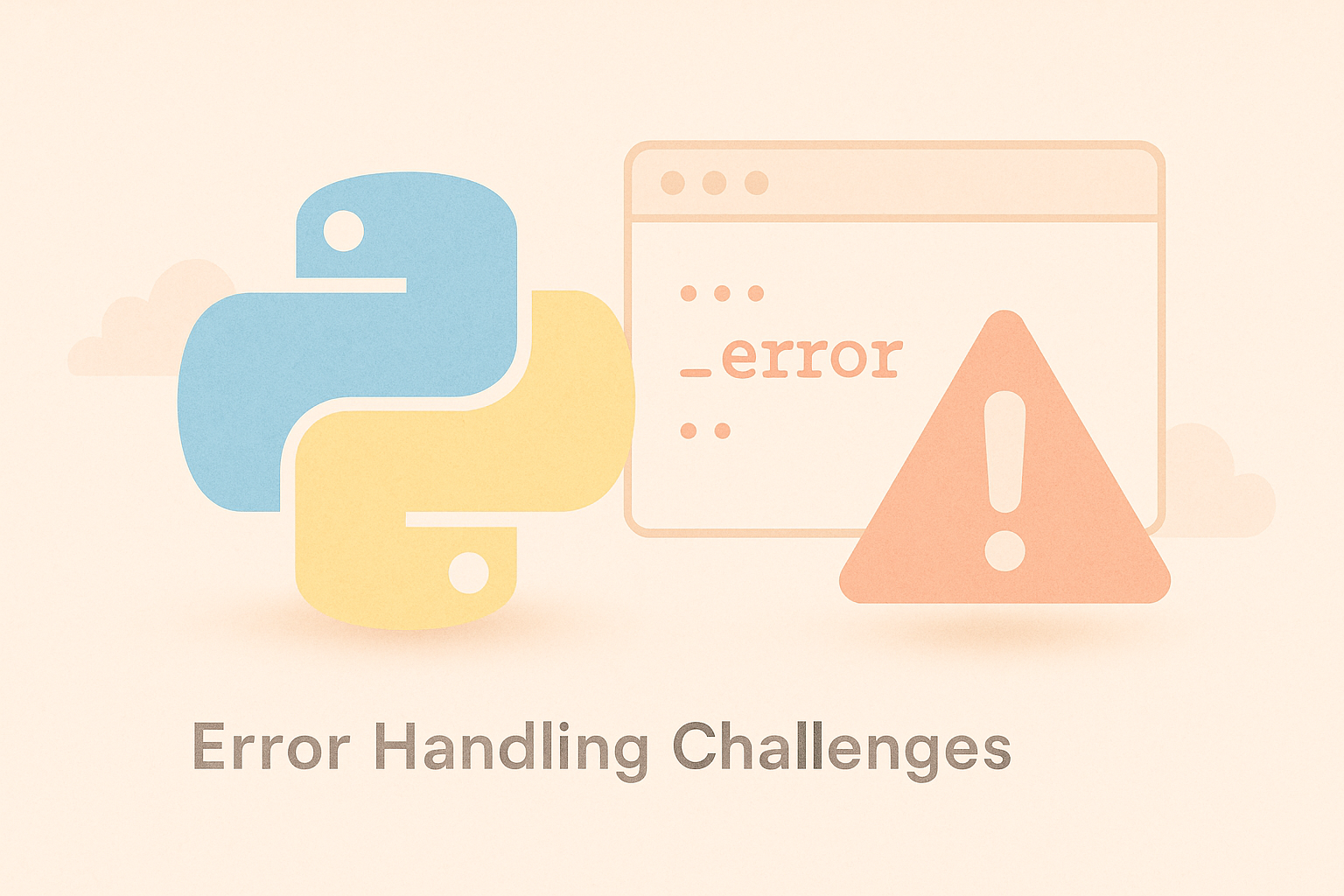In programming, errors are inevitable. Whether you are a beginner or an experienced developer, understanding how to handle errors effectively is an essential skill. In Python, error handling is primarily done through exceptions. This article will help you explore the most common Python error handling challenges, learn how to manage exceptions, and improve the reliability of your programs through practical examples.

1. What is Error Handling in Python?
Error handling is a process that allows a program to respond gracefully when something unexpected happens during execution. Without proper error handling, your Python program will crash as soon as it encounters a problem, such as dividing by zero or accessing an undefined variable.
In Python, the try-except block is used to handle such situations:
try:
result = 10 / 0
except ZeroDivisionError:
print("You cannot divide by zero!")
Here, Python tries to execute the code inside the try block. If an error occurs, the code inside the except block is executed instead of stopping the entire program.
2. Common Python Error Handling Challenges
Challenge 1: Catching Too Many Exceptions
One of the most common mistakes beginners make is using a generic except: clause that catches all exceptions. This may hide bugs and make debugging harder.
# Avoid this
try:
number = int(input("Enter a number: "))
except:
print("Something went wrong!") # Too generic
Instead, handle specific exception types:
try:
number = int(input("Enter a number: "))
except ValueError:
print("Invalid input. Please enter a valid integer.")
Challenge 2: Ignoring Exceptions Without Action
Sometimes developers use pass to ignore errors, but this can cause issues later when the program behaves unexpectedly.
try:
file = open("data.txt", "r")
except FileNotFoundError:
pass # silently ignores the error
Instead of ignoring, handle the problem or give feedback:
try:
file = open("data.txt", "r")
except FileNotFoundError:
print("File not found. Please check the filename and try again.")
Challenge 3: Misusing Finally and Else Blocks
Python allows you to use else and finally with error handling to make code more predictable:
- else: runs if no exception occurs
- finally: runs no matter what, even if an error happens
try:
num = int(input("Enter a number: "))
except ValueError:
print("Invalid input!")
else:
print("You entered:", num)
finally:
print("Program execution finished.")
Challenge 4: Re-raising Exceptions Incorrectly
Sometimes, you might want to handle an exception but still raise it again. Beginners often re-raise it incorrectly, losing the original traceback.
try:
result = 1 / 0
except ZeroDivisionError as e:
print("Error occurred:", e)
raise # Proper way to re-raise
Challenge 5: Not Logging Exceptions
In larger applications, simply printing an error message is not enough. It’s better to use Python’s logging module to record errors for debugging and monitoring.
import logging
logging.basicConfig(filename="error.log", level=logging.ERROR)
try:
x = 1 / 0
except Exception as e:
logging.error("An error occurred: %s", e)
3. Best Practices for Python Error Handling
- Use specific exceptions instead of general ones.
- Keep try blocks small—only wrap the code that may fail.
- Log errors for debugging instead of hiding them.
- Use finally to clean up resources like files or network connections.
- Raise meaningful exceptions to communicate problems clearly.
4. Advanced Example: File Processing with Exception Handling
Let’s create a simple program that reads numbers from a file and handles potential errors gracefully.
def read_numbers_from_file(filename):
numbers = []
try:
with open(filename, "r") as file:
for line in file:
try:
number = float(line.strip())
numbers.append(number)
except ValueError:
print(f"Invalid number found: {line.strip()}")
except FileNotFoundError:
print("File not found. Please provide a valid filename.")
except Exception as e:
print("Unexpected error:", e)
else:
print("File read successfully.")
finally:
print("Process completed.")
return numbers
# Example usage
data = read_numbers_from_file("numbers.txt")
print("Numbers:", data)
This code demonstrates how to handle multiple exception types at different levels. It ensures that the program doesn’t crash even if some data is invalid or the file doesn’t exist.
5. Custom Exceptions in Python
In real-world projects, you might want to define your own exceptions to make your code more readable and specific.
class NegativeNumberError(Exception):
pass
def process_number(num):
if num < 0:
raise NegativeNumberError("Negative numbers are not allowed.")
return num * 2
try:
print(process_number(-5))
except NegativeNumberError as e:
print("Custom Error:", e)
6. Common Pitfalls to Avoid
- Don’t use bare
except:clauses. - Don’t ignore exceptions silently.
- Always clean up resources (files, sockets, etc.) in
finally. - Document possible exceptions in your functions.
7. Conclusion
Python error handling can be challenging, especially for beginners. However, mastering it is critical for writing robust and maintainable code. By practicing specific exception handling, logging errors, and understanding try, except, else, and finally blocks, you can make your Python programs more reliable and professional.
Keep experimenting, handle errors wisely, and remember — the best programmers aren’t those who never face errors, but those who know how to handle them efficiently.

